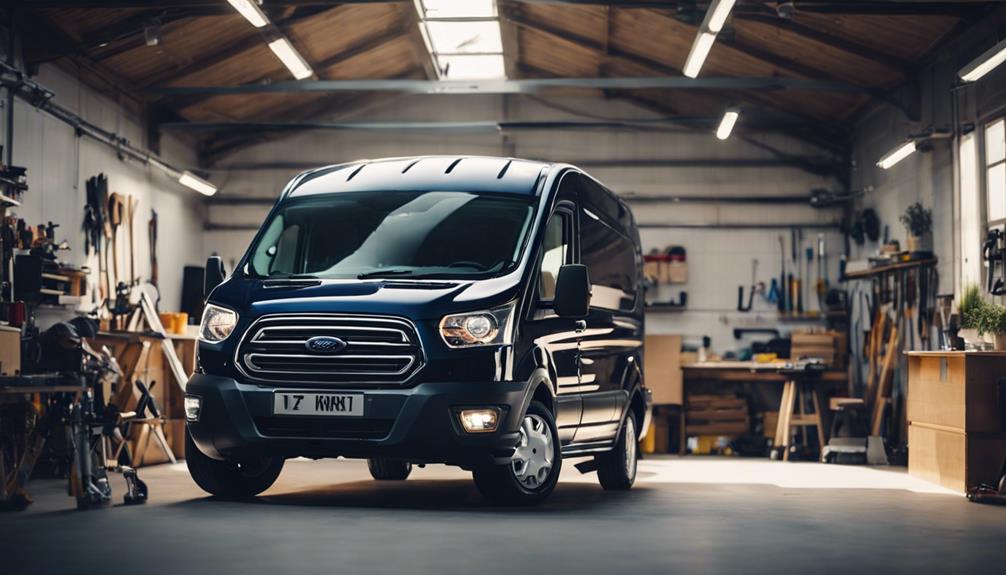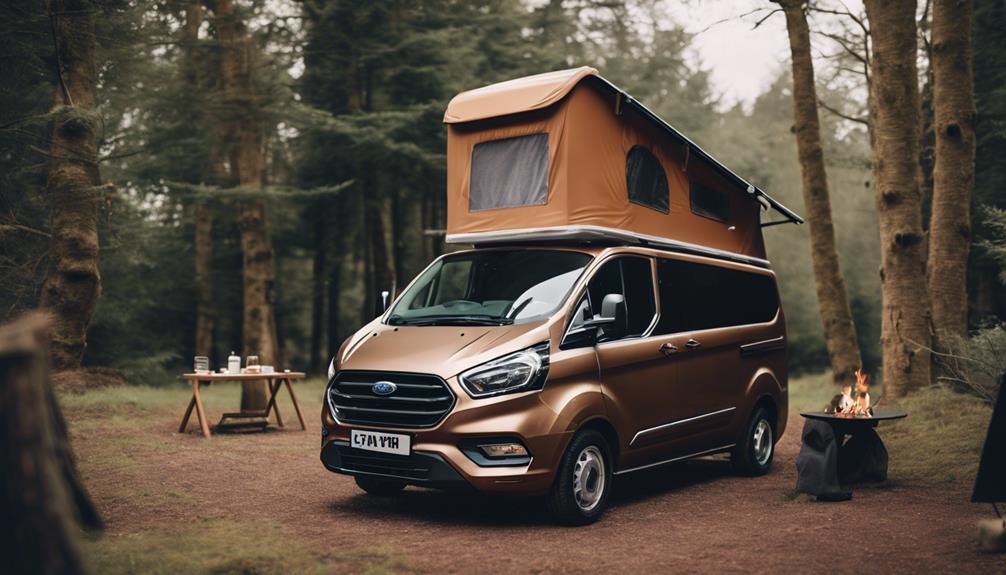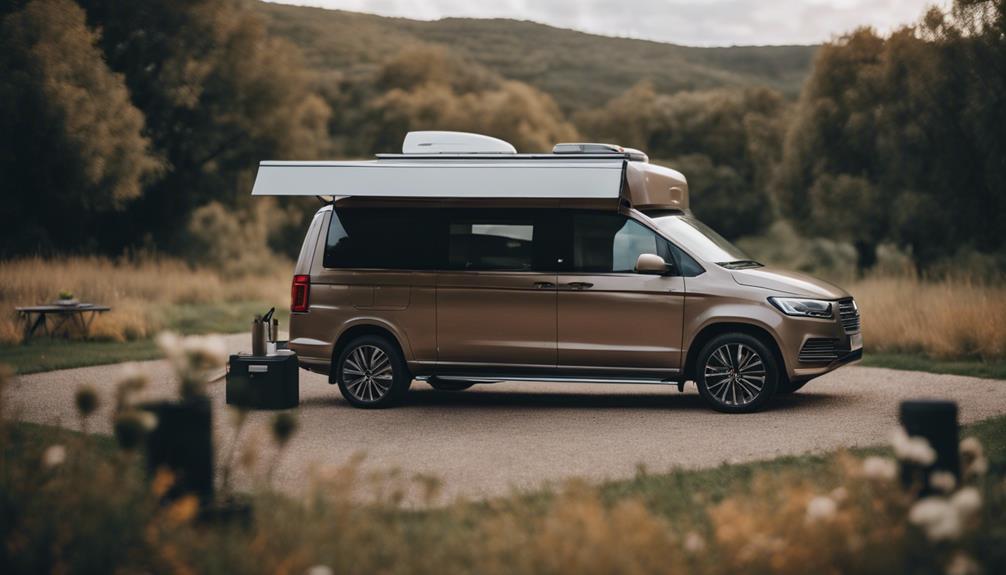When considering a Ford Transit for camper conversion, you'll have several fantastic options. The Cargo Van, Crew Van, and Passenger Van all cater to various needs. If you want plenty of headroom, the High Roof model is perfect. You can customize the interior to fit your requirements, whether that means adding a kitchen or a bathroom. Choose between the 3.5L PFDi V6 for basic needs or the 3.5L EcoBoost V6 for maximum power and efficiency. With different length options and configurations, your ideal camper build is within reach. There's more to explore on making the right choice.
Introduction
If you're considering a camper conversion, the Ford Transit offers versatile options that cater to your space and lifestyle needs.
With configurations like the Cargo Van, Crew Van, and Passenger Van, you can choose the layout that best fits your travel style. If you're planning on living full-time in your camper, the High Roof model stands out, providing ample standing room and comfort for daily activities.
The Transit's customizable interior allows you to add essential amenities, such as kitchens and bathrooms, making your camper van conversions more functional. You can opt for lengths ranging from Regular to Extended, which is perfect for those who need extra room for living and storage.
Under the hood, the Transit boasts engine options, including the EcoBoost V6 Engine, which is ideal for heavier setups due to its superior towing capacity and fuel efficiency.
Whether you prioritize space, comfort, or performance, the Ford Transit has the features you need to create your dream camper van. With its extensive cargo capacity and flexible design, you can tailor your Transit to suit your unique travel needs.
Background Information
Camper vans have become incredibly popular lately, and it's no surprise that Ford's Transit line stands out among the options.
With new engine choices available, you can tailor your ride to match your adventure needs.
Let's explore how these features can enhance your camper conversion experience.
Camper Van Popularity Surge
A remarkable surge in camper van conversions reflects a growing desire for flexible and mobile living, especially among younger generations embracing the van life movement. The Ford Transit van has emerged as a top choice for these conversions, thanks to its spacious interiors and versatile configurations. As more people seek adventure vans that allow them to explore the great outdoors, the demand for campervan conversions continues to rise.
During the pandemic, many individuals turned to outdoor recreation and travel experiences, driving up sales and conversions of camper vans. Online communities have flourished, sharing tips, designs, and inspiring stories that fuel this trend. Professional conversion companies now face a backlog of orders, highlighting the strong market for personalized camper spaces in vehicles like the Ford Transit.
Moreover, converting a Ford Transit into a camper is often more affordable than purchasing a traditional RV, making it an appealing option for budget-conscious travelers. With the combination of flexibility, community support, and cost-effectiveness, it's no wonder that the popularity of camper van conversions is skyrocketing.
Embrace the van life and discover the freedom it offers!
New Engine Options Available
Ford has rolled out new engine options for the Transit that boost performance and efficiency, making it an even more appealing choice for your camper conversion. You can choose between the 3.5L PFDi V6 engine, which delivers 275 horsepower and 262 lb-ft of torque, or the robust 3.5L EcoBoost V6 engine, offering 310 horsepower and an impressive 400 lb-ft of torque. If you're planning to tow or drive at higher elevations, the EcoBoost V6 is the way to go, as it excels in those conditions.
Both engine options come with a 10-speed SelectShift transmission, enhancing your driving experience by allowing for seamless gear changes. Fuel efficiency is another strong suit of the EcoBoost, essential for those long-distance journeys in your camper conversion.
Starting in the 2020 model year, all-wheel drive (AWD) became available, providing better traction and handling on various terrains, which can be especially beneficial for camper use. With these new engine options, the Ford Transit stands ready to meet your adventure needs while keeping performance and comfort at the forefront.
New Engine Specifications Released

You'll want to contemplate the new engine specifications as they introduce emerging technologies that enhance your driving experience.
With options like the EcoBoost engine, you gain better fuel efficiency and power, perfect for your camper conversion needs.
These advancements not only improve performance but also impact the resale value of your Transit.
Emerging Engine Technologies
Emerging engine technologies in the Ford Transit offer impressive power and efficiency, making it an excellent choice for camper conversions.
You'll find two solid engine options: the 3.5L PFDi V6, which delivers 275 HP and 262 lb-ft of torque, and the robust 3.5L EcoBoost V6, generating 310 HP and a hefty 400 lb-ft of torque. The EcoBoost is especially advantageous for those who plan on tackling higher altitudes or need better fuel efficiency for long trips.
Both engine options come with a 10-speed SelectShift automatic transmission, ensuring a smooth ride and adaptability to various driving conditions during your travels.
If you're considering off-road adventures or diverse terrains, the introduction of all-wheel drive (AWD) in 2020 enhances traction and stability, making the Transit a reliable choice.
Additionally, the Transit boasts a maximum towing capacity of up to 7,500 pounds with the heavy-duty trailer tow package. This capability allows you to tow larger trailers or extra gear, which is essential for extended camper adventures.
With these emerging engine technologies, the Ford Transit stands out for those seeking performance and versatility in their camper conversion.
Enhanced Fuel Efficiency Options
Exploring enhanced fuel efficiency options reveals that the 3.5L EcoBoost V6 engine considerably outperforms the standard PFDi V6, making it a top choice for long-distance camper conversions. This EcoBoost engine delivers an impressive 310 horsepower and 400 lb-ft of torque, ensuring you enjoy robust performance without sacrificing fuel efficiency.
When you opt for the Ford Transit equipped with the EcoBoost engine, you're not just getting power; you're also enhancing your overall driving experience. With turbocharging, this engine excels at higher altitudes, which is perfect for varied terrains you might encounter during your camping adventures.
Both engine options come with a 10-speed automatic SelectShift transmission, which promotes smoother driving and optimizes fuel consumption further. This means you can travel longer distances on less fuel, allowing you to explore more without worrying about frequent stops at the pump.
Moreover, choosing the EcoBoost engine can lead to a higher resale value, making it a smart investment for your camper conversion. Fundamentally, the EcoBoost engine combines performance and efficiency, making your Ford Transit an exceptional choice for any camper enthusiast.
Engine Performance Comparison
When considering engine performance for your camper conversion, you'll want to weigh the advantages and disadvantages of each option.
Mechanics often highlight how the EcoBoost engine excels in torque and towing capacity, making it a top choice for heavy loads.
Let's evaluate how these engines stack up in real-world scenarios to help you make the best decision for your travels.
Advantages and Disadvantages
Choosing between the 3.5L EcoBoost V6 and the 3.5L PFDi V6 engines can considerably impact your camper conversion experience, especially regarding engine performance and adaptability to your specific needs.
If you're planning a Ford Transit Crew with a more substantial campervan conversion, the EcoBoost engine shines with its impressive 310 HP and 400 lb-ft of torque. This power translates to enhanced towing capacity, making it ideal for hauling heavier loads and traversing mountainous terrains.
On the flip side, the PFDi V6 offers a reliable, more economical option with 275 HP and 262 lb-ft of torque. While it suits basic needs, it may struggle with heavier setups and steep inclines, which can be a significant drawback if your camper's electrical system requires more power.
Fuel efficiency is another critical factor; the EcoBoost engine excels here, reducing your travel costs on long trips. Finally, the potential for higher resale value with the EcoBoost could be a deciding factor for future buyers interested in camper conversions.
Ultimately, the choice hinges on your specific requirements and how you plan to use your Ford Transit.
Mechanics' Insights on Performance
Mechanics emphasize that the choice between the EcoBoost and PFDi engines greatly affects overall performance in camper conversions.
The Ford Transit offers two compelling engine options: the 3.5L PFDi V6 and the more powerful 3.5L EcoBoost V6. The EcoBoost engine, generating 310 HP and 400 lb-ft of torque, is particularly beneficial for heavier Transit camper van setups, providing the extra muscle needed for those long trips.
Fuel efficiency is another area where the EcoBoost shines, especially at altitude, making it a wise choice for those planning extended journeys. Both engines are paired with a smooth 10-speed automatic SelectShift transmission, which enhances your driving experience and adapts well to various conditions.
When it comes to traction, the Transit's rear-wheel drive (RWD) has been standard from 2015-2019, but all-wheel drive (AWD) options became available in 2020, offering improved handling on diverse terrains. Additionally, higher axle ratios help maintain stability and performance, essential for safely maneuvering heavy loads during your camping adventures.
Ultimately, your engine choice will greatly influence your camper's performance and capability.
Engine Performance Evaluation
Evaluating engine performance reveals notable differences between the Ford Transit's 3.5L PFDi V6 and the 3.5L EcoBoost V6, impacting your camper conversion experience.
The PFDi V6 offers 275 HP and 262 lb-ft of torque, which is adequate for basic needs. However, if you're considering extensive camping conversions and require more power, the EcoBoost V6 shines with 310 HP and 400 lb-ft of torque. This engine not only enhances performance but also boosts fuel efficiency, making long-distance travel smoother.
Both engines come with a 10-speed automatic SelectShift transmission, offering you flexibility in gear selection for any driving scenario.
When it comes to traction and handling, your choice between Rear-Wheel Drive (RWD) and All-Wheel Drive (AWD) matters considerably. AWD is particularly beneficial for those who plan to navigate rough terrains, enhancing your camping experience.
Additionally, higher axle ratios available in the Transit contribute to better performance under heavy loads and steep inclines, essential for maintaining engine performance during your adventures.
Ultimately, the EcoBoost's advantages make it the preferred choice for serious camper conversions.
Essential Maintenance Checklist

Keeping your camper conversion in top shape starts with a solid maintenance routine.
You'll want to stick to a regular oil change schedule, ideally every 5,000 to 7,500 miles, to keep your engine running smoothly.
Let's go over some essential checks that'll help you avoid costly repairs down the line.
Maintenance Routine Overview
How can you guarantee your camper conversion stays in top shape? A solid maintenance routine is essential.
Start with regular oil changes, which you should schedule every 5,000 to 7,500 miles, depending on your driving conditions. This keeps your engine healthy and running smoothly.
For safety, check brake pad replacements every 20,000 to 50,000 miles; this is especially important since camper conversions often carry extra weight.
Don't forget about your tires! Regularly check tire pressure, keeping it between 30-35 psi for ideal fuel efficiency and handling. Additionally, rotate your tires to extend their lifespan.
Fluid levels are another vital aspect. Inspect coolant, transmission fluid, and brake fluid frequently, and plan for a complete flush every 30,000 to 60,000 miles to avoid system failures.
Regular Oil Change Schedule
To guarantee your camper conversion runs smoothly, stick to a regular oil change schedule that typically falls between 5,000 to 7,500 miles, depending on the oil type you use. Regular oil changes are fundamental for maintaining engine health, making sure that your vehicle operates efficiently and reliably.
If you opt for synthetic oil, you can extend your oil change interval to every 7,500 to 10,000 miles, offering enhanced protection against wear and tear.
Remember, an oil change isn't just about replacing the oil; it's important to change the oil filter too. This makes certain that contaminants are effectively removed, keeping the oil clean and your engine running at peak performance.
Additionally, regularly checking your oil level between changes is crucial. If your oil level is low, it can lead to significant engine wear and potential damage.
To keep track of your maintenance routine, maintain a maintenance log that records oil change dates and mileage. This will help you stay on top of your oil change schedule and ensure your camper conversion remains in great shape for all your adventures.
What Makes Ford Transit a Popular Choice for Camper Conversion Compared to Buses?
The Ford Transit is a popular choice for camper conversion compared to buses. Its compact size and versatile design make it one of the best bus camper conversion homes on the market. With ample headroom and a practical layout, the Ford Transit provides the perfect foundation for creating a comfortable and functional camper.
What are the benefits of choosing a Ford Transit for Camper Conversion over other options?
When it comes to camper conversion, choosing the best durable transit van like the Ford Transit offers numerous benefits. With its spacious interior, customizable features, and reliable reputation, the Ford Transit is a top choice for turning into a camper. Its durability and versatility make it stand out among other options.
Conclusion
In choosing a Ford Transit for your camper conversion, you'll find a range of options that cater to your specific needs for space, power, and comfort.
The versatility of Transit vans allows you to select from various roof heights, including the high roof, which provides up to 76 inches of headroom. This additional space can make a significant difference in your living experience on the road.
For heavier setups, you'll likely want to take into account the EcoBoost V6 engine. Its superior power and towing capacity are invaluable for ensuring your camper conversion performs well, especially when fully loaded.
Additionally, deciding between dual rear wheels (DRW) and single rear wheels (SRW) can impact both your vehicle's stability and interior space.
Ultimately, it's important to keep the Gross Vehicle Weight Rating (GVWR) in mind during your camper conversion. Proper weight distribution is key to maintaining safety and performance while you're out exploring.
Frequently Asked Questions
Is Ford Transit Good for Camper Conversion?
Absolutely, the Ford Transit's spacious interior and versatile configurations make it perfect for camper conversion. Its engine options and all-wheel drive enhance your adventures, while customization possibilities guarantee your setup matches your lifestyle perfectly.
What Type of Van Is Best for Camper Conversion?
For camper conversion, you'll want a van with ample cargo space and height. High roof models are perfect for standing, while long wheelbase options balance space and drivability, ensuring your comfort on the road.
What Is the Difference Between a Ford Transit Custom and a Ford Transit?
The Ford Transit Custom's smaller size and lower roof suit compact needs, while the standard Ford Transit offers various heights and longer wheelbases, providing more space and power for extensive conversions and heavier loads.
How Much Does a Ford Transit Conversion Cost?
A Ford Transit conversion can cost between $7,000 for basic builds and over $100,000 for luxury options. Your budget will depend on design complexity, materials, and whether you choose DIY or professional services.
Conclusion
To summarize, choosing the right Ford Transit for your camper conversion is vital for a smooth and enjoyable experience.
With new engine specs and performance comparisons, you've got the information you need to make an informed decision.
Just remember to keep up with essential maintenance to guarantee your ride stays in top shape.
Whether you're hitting the open road or exploring hidden gems, the right Transit can make all the difference in your adventures.
Happy travels!



















